What does the Bible really reveal about using instruments in church worship? Dive into the debate that spans centuries and cultures.
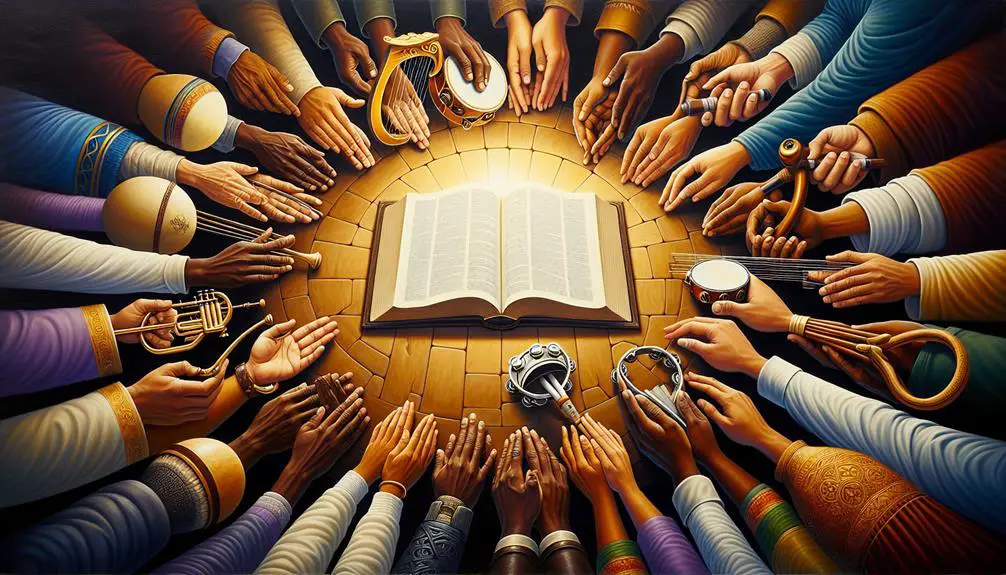
What Does the Bible Say About Instruments in Church
Well, if you've ever wondered whether David rocked an electric harp or if the apostle Paul jammed on a keyboard, you're not alone in pondering what the Bible actually says about instruments in church. The scripture's take ranges from Old Testament traditions rich in psalms and praise to a rather silent stance in the New Testament, leaving much to interpretation.
As you navigate through the layers of theological arguments and early church practices, you'll find that the modern perspectives on this topic are as varied as the instruments themselves. Let's embark on a journey to uncover these nuances, shall we?
Key Takeaways
- The Old Testament features instruments prominently in worship and ceremonies, suggesting historical acceptance.
- Psalms emphasize music's role in emotional and spiritual worship experiences.
- The New Testament's silence on instruments does not necessarily imply prohibition in worship.
- Church tradition and modern perspectives have evolved to broadly accept various musical instruments in worship.
Old Testament Traditions
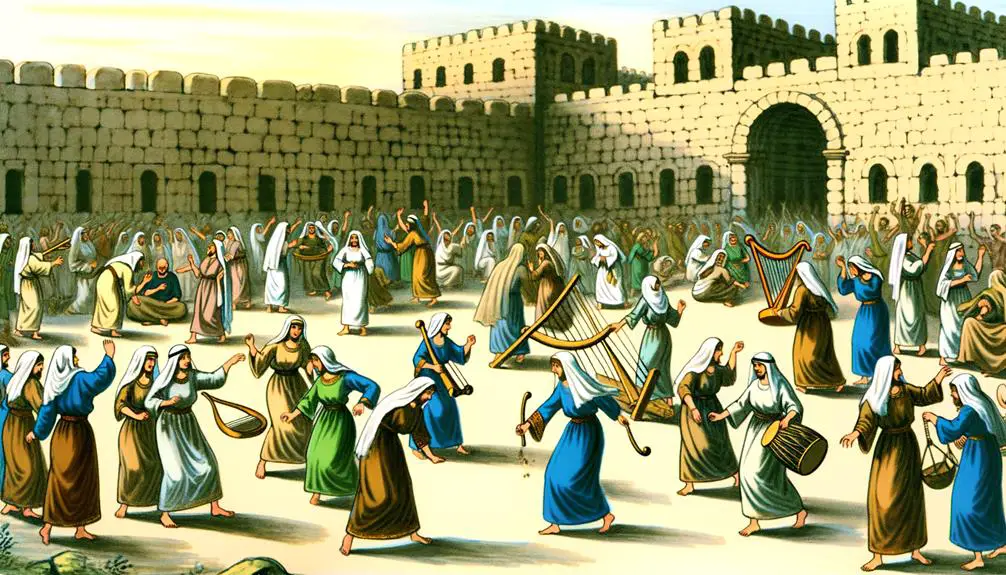
The Old Testament chronicles the use of various musical instruments in worship and religious ceremonies, highlighting their integral role in ancient Hebrew culture and religious practices. Instruments weren't merely for aesthetic pleasure; they served as vital components in Tabernacle rituals and Sacrificial ceremonies, enhancing the solemnity and sanctity of these events.
In the context of Tabernacle rituals, instruments like trumpets and horns weren't just musical accompaniments but served as calls to assembly, signals for movement, and means to announce significant religious days. This use underscores the functional aspect of instruments in orchestrating community religious life, ensuring that worship was a unified, communal act.
During Sacrificial ceremonies, instruments took on a deeper, more profound role. The sounding of trumpets and the playing of stringed instruments accompanied offerings, signifying the community's earnest plea for atonement and divine favor. This auditory component of the sacrifice ritual underscored the solemnity of the act, creating an atmosphere of reverence and awe.
Analyzing these practices reveals that instruments in the Old Testament weren't mere adornments to worship; they were imbued with theological significance. They facilitated communication between the divine and the mortal, encoded ritual actions with deeper meaning, and unified the community in their religious observances. This historical perspective offers a rich tapestry of meaning and function behind the use of instruments in ancient worship, suggesting that their role was as multifaceted as it was vital.
Psalms and Praise

Delving into the Book of Psalms, one finds that it serves as a profound testament to the central role of music and instruments in expressions of praise and worship. This collection of poetic writings not only offers lyrical meditation but also stands as a cornerstone for musical prophecy within the scriptural context. Indeed, the Psalms articulate an ethos where musical instruments are integral to the fabric of divine adoration.
The Psalms convey a rich tapestry of emotional and spiritual experiences, utilizing music as a dynamic vehicle for communication with the divine. This is not merely about the creation of harmonious sounds but also about the embodiment of prayer, praise, and prophecy through the medium of music. The inclusion of instruments in these sacred texts underscores their significance in facilitating a deeper connection between the worshippers and the worshipped.
To illustrate, consider the following excerpts from the Psalms:
Psalm |
Instrument Mentioned |
Purpose |
|---|---|---|
150 |
Trumpet, Harp, Lyre |
Praise |
33 |
Lyre, Harp |
Joy |
81 |
Tambourine, Lyre |
Jubilation |
98 |
Trumpet, Ram's Horn |
Victory |
These references not only highlight the diversity of instruments employed in worship but also underscore the multifaceted roles they play in expressions of faith. From joy to jubilation, from praise to victory, the instruments mentioned in the Psalms enrich the spiritual landscape, offering a multi-sensory experience of divine connection.
New Testament Silence
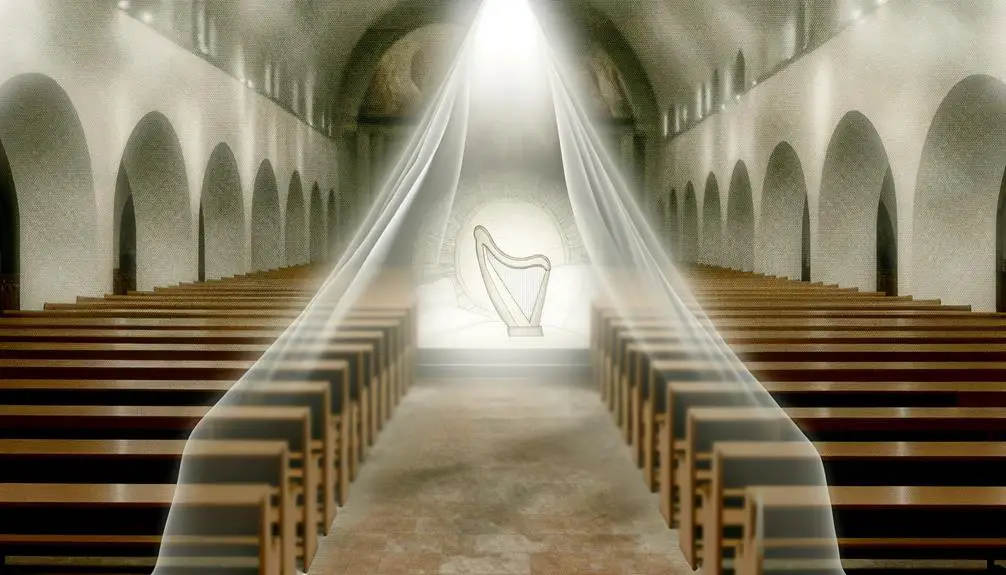
You may notice the New Testament's lack of explicit references to instrumental worship, a contrast to the Old Testament's rich tapestry of musical praise.
This silence raises questions about the continuity of worship practices and how early Christians interpreted these absences.
It's crucial to examine the roles of Old Testament precedents, the interpretation of silence, and church tradition in understanding this shift.
Old Testament Precedents
In examining the Old Testament, we find a rich tapestry of musical instruments integral to worship, contrasting with the New Testament's relative silence on the subject. Instruments played a pivotal role in temple rituals and sacrificial ceremonies, signaling a divine sanction of music in spiritual practices. This historical context underscores a disparity in scriptural emphasis.
Instrument |
Usage Context |
Reference |
|---|---|---|
Harp |
Temple worship |
1 Chronicles 25:1 |
Trumpet |
Proclamation and celebration |
Numbers 10:10 |
Cymbals |
Accompaniment in praise |
2 Chronicles 5:12 |
Lyre |
Psalm accompaniment |
Psalm 33:2 |
This table illustrates the variety and significance of musical instruments in the Old Testament, highlighting their ceremonial and worshipful applications.
Interpretation of Silence
While the Old Testament vividly documents the use of musical instruments in worship, the New Testament's silence on this matter invites a careful examination of its implications for contemporary worship practices. This absence doesn't necessarily indicate prohibition. Instead, it's a space where cultural norms and silent communication shape understanding.
You're tasked with deciphering whether this silence is a tacit endorsement or a neutral stance, allowing for cultural adaptation over time. Historically, interpreting silent communication in religious texts requires a nuanced understanding of context. The New Testament's silence might reflect the cultural norms of its time, suggesting that worship practices, including the use of instruments, are adaptable, guided by the principles of faithfulness and community engagement rather than rigid prescriptions.
Church Tradition Roles
The New Testament's silence on specific church traditions, including musical worship, challenges scholars to delve into the historical and cultural context to understand its implications for modern practices. This silence leaves room for interpretation on aspects like:
- The use of liturgical colors to mark different seasons of the Christian calendar.
- The significance of clergy attire in conveying theological and pastoral roles.
- The evolution of musical instruments from cultural adaptations rather than explicit biblical mandates.
- The role of tradition in shaping the liturgical life of the church, bridging the gap between scriptural silence and contemporary worship practices.
Analyzing these elements shows how traditions like liturgical colors and clergy attire play crucial roles in the life of the church, despite the New Testament's lack of explicit guidance.
Early Church Practices
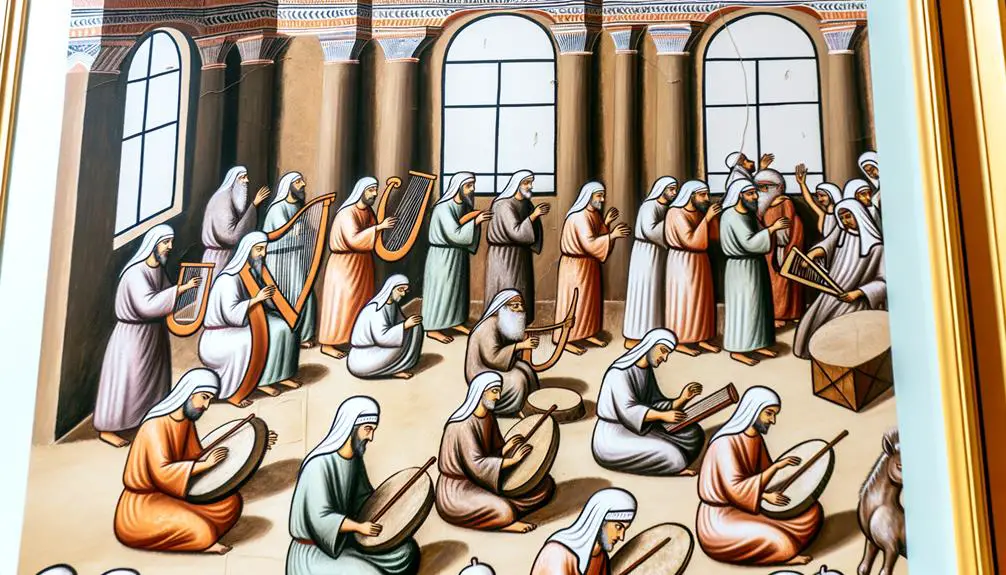
How did early church practices shape the use of musical instruments during worship services?
To understand this, you'll need to delve into the nature of communal gatherings in the nascent stages of Christianity. These were deeply influenced by apostolic teachings, which emphasized simplicity, devotion, and a focus on the spoken word.
The early Christian communities gathered in homes or in small, inconspicuous places, primarily due to the socio-political climate that often was hostile toward them. Within these intimate settings, the emphasis was on preaching, prayer, and the singing of psalms and hymns, often without the accompaniment of instruments. This practice wasn't merely a result of logistical constraints but was deeply rooted in the theological and philosophical outlook of early Christians, who valued the purity of vocal praise and the directness of communication it facilitated with the divine.
Moreover, the apostolic tradition, as recorded in the New Testament, provides scant evidence of instrumental music in the worship practices of the earliest Christian communities. This absence is notable, especially when contrasted with the rich musical traditions of the Jewish Temple worship from which Christianity emerged.
The early church fathers, drawing on apostolic teachings, often advocated for vocal music as a means of preserving the solemnity and sanctity of Christian worship. This perspective underscores the early church's cautious approach toward incorporating elements from contemporary secular or pagan culture, including musical instruments, into their worship practices.
As such, the use of instruments in worship wasn't a prominent feature of early Christian gatherings, reflecting a deliberate theological and cultural choice rather than a mere circumstantial necessity.
Theological Arguments
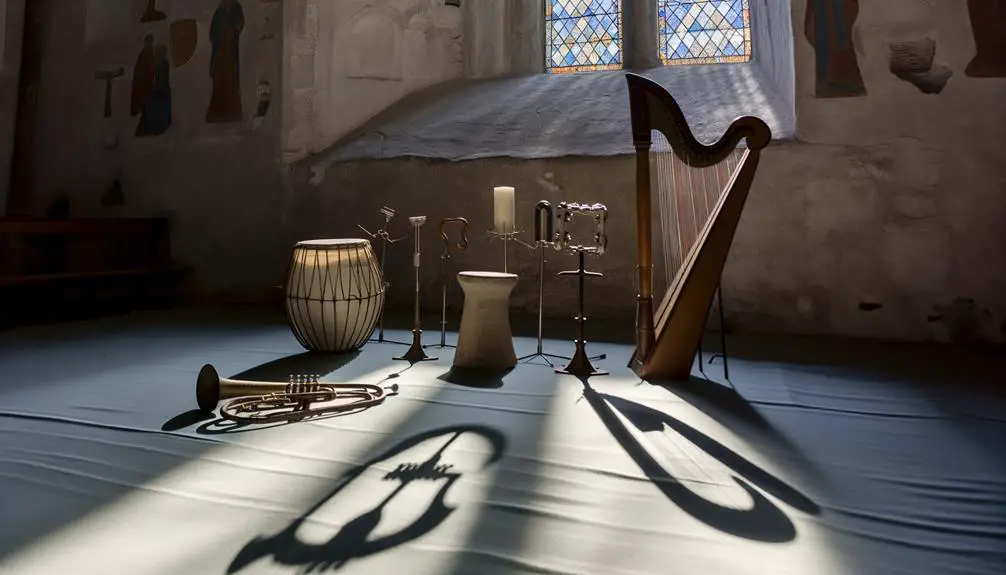
You must examine how biblical references to instrument usage inform ongoing debates on their role in worship. This scrutiny reveals contrasting interpretations that pivot around whether they enhance or detract from spiritual experiences.
Furthermore, you'll explore how these perspectives align or conflict with early church practices, providing a nuanced understanding of the theological arguments at play.
Biblical Instrument Usage
Delving into biblical texts reveals that instruments played a pivotal role in worship and ceremonies, sparking diverse theological debates about their use in contemporary church settings. This discussion often centers around two key aspects: musical evolution and instrumental controversy.
- Musical Evolution: Scripture shows a progression in instrument use, reflecting shifts in worship practices and societal norms.
- Instrumental Controversy: The debate isn't new; historical divisions over instruments in worship trace back to early church fathers.
- Scriptural References: Psalms, particularly, underscore the use of instruments in praising God, offering a biblical precedent.
- Cultural Context: Understanding the cultural backdrop of biblical times is crucial in interpreting the role and significance of instruments in worship.
Analyzing these elements provides a nuanced view of the theological arguments surrounding biblical instrument usage.
Worship Enhancement Debate
Moving beyond the historical and scriptural examination of instruments in worship, it's crucial to explore the theological arguments that frame the debate on whether instrumental music enhances or detracts from the worship experience.
Aspect |
Enhancement Argument |
Detraction Argument |
|---|---|---|
Sound Levels |
Promotes engagement |
Can overpower words |
Cultural Influence |
Bridges gaps |
May impose styles |
Theological Basis |
Supports expression |
Distracts focus |
Emotional Impact |
Deepens experience |
Overwhelms senses |
Community Effect |
Unites participants |
Divides preferences |
Analyzing these dimensions reveals that sound levels and cultural influence are pivotal. While proponents argue that instruments adapt worship to contemporary sensibilities, critics worry about losing the essence and clarity of worship, highlighting the need for a balanced, context-sensitive approach.
Early Church Practices
To understand the role of instruments in early Christian worship, it's essential to examine the theological arguments prevalent during that period. The early church's practices were deeply influenced by:
- Gentile Inclusion: The admission of Gentiles into the Christian community without demanding adherence to Jewish customs may have influenced the acceptance or rejection of instruments in worship.
- Apostolic Teachings: The teachings and traditions passed down from the apostles played a crucial role in shaping worship practices, including the use or avoidance of musical instruments.
- Scriptural Interpretations: Early Christians interpreted scriptures in a way that either supported or opposed the use of instruments in worship.
- Cultural Context: The surrounding cultural practices of music in worship affected early Christian attitudes towards instruments.
Analyzing these factors reveals a complex interplay of theology, tradition, and culture in early church practices.
Modern Perspectives
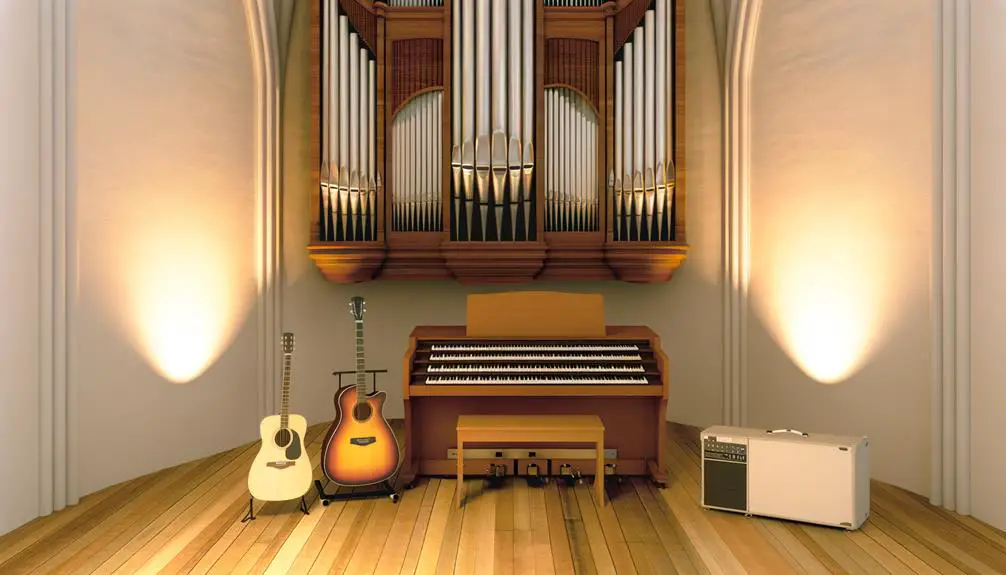
Contemporary discussions often center on how the use of instruments in church services aligns with biblical teachings. You're navigating a landscape where cultural influences and technological advancements significantly shape perspectives on this matter. It's crucial to recognize that cultural shifts have led to a broader acceptance of various musical styles and instruments in worship settings. This change reflects a desire to connect with a diverse congregation whose musical tastes and spiritual experiences are as varied as their backgrounds.
Technological advancements have also played a pivotal role. They've not only made a wider range of instruments accessible for worship but have also enhanced the quality of music produced, facilitating a more immersive worship experience. You might find it intriguing that these developments have led to debates within communities about maintaining traditional worship forms versus embracing contemporary practices.
Analyzing modern perspectives requires an understanding of how these factors interact with scriptural interpretations. Scholars and church leaders often engage in deep theological discussions to discern how, or if, these changes align with biblical directives for worship. You're witnessing an era where the emphasis on personal connection with the divine through music challenges traditional norms, yet strives to remain rooted in biblical principles.
In navigating these discussions, it's essential to approach them with an open mind and a scholarly rigor, recognizing that the integration of instruments in worship is a complex issue influenced by evolving cultural and technological contexts. The goal remains to facilitate a worship experience that honors biblical teachings while resonating with today's congregation.
Frequently Asked Questions
How Does the Use of Musical Instruments in Church Affect Congregational Participation and Inclusivity?
Using musical instruments in church can greatly enhance worship dynamics, encouraging diverse singing styles and fostering a sense of unity.
It's been observed that instruments can draw in congregants, making participation more inclusive, especially for those who might feel self-conscious about their singing abilities.
The variety in musical accompaniment allows everyone to find their comfort zone, thereby increasing engagement and making the worship experience more accessible and enjoyable for all attendees.
Are There Specific Types of Instruments That Are More or Less Appropriate for Worship Settings, According to Various Denominations?
You're opening a can of worms when you delve into which instruments are deemed appropriate for worship across denominations. The debate often hinges on instrumental origins and Scriptural silence on the matter.
Some congregations embrace a wide range of instruments, seeing them as vehicles for joyful noise, while others advocate for a more conservative approach, favoring traditional or scripturally referenced instruments to maintain a solemn worship atmosphere.
How Have Technological Advancements, Like Electronic Instruments and Sound Amplification, Impacted the Biblical Perspective on Using Instruments in Worship?
Technological advancements, like electronic instruments and sound amplification, haven't directly changed biblical views on using instruments in worship. However, they've influenced worship trends and sound quality.
You'll find that these innovations allow for a broader variety of musical styles and enhance the worship experience. They've made worship more accessible and dynamic, adapting to contemporary tastes while maintaining the core purpose of enhancing the spiritual atmosphere and facilitating congregational participation.
What Role Do Cultural Differences Play in the Acceptance and Integration of Musical Instruments in Church Services Globally?
Cultural differences significantly shape the acceptance and integration of musical instruments in church services worldwide. You'll find that global uniformity doesn't exist due to historical evolution and diverse interpretations of worship practices.
As you delve deeper, it becomes clear that these variations aren't merely superficial but reflect the rich tapestry of faith expressions. Analyzing this diversity offers a broader understanding of how communities connect with the divine through music, beyond mere textual guidelines.
Can the Use of Instruments in Worship Services Be a Form of Outreach or Evangelism, and if So, How Is This Approach Viewed Biblically?
You might wonder if using instruments in worship services can act as outreach or evangelism. Biblically, the approach to instrumental history and worship styles reveals a nuanced perspective. Instruments in worship have evolved, reflecting diverse cultural expressions and enhancing the spiritual experience.
Analyzing scripture shows that while specific directives about instruments are scarce, their use in outreach aligns with the broader biblical endorsement of creativity and diversity in worship practices.
Conclusion
In conclusion, the Bible's stance on instruments in church varies, with the Old Testament endorsing their use in Psalms and the New Testament remaining silent.
Historical practices and theological arguments further complicate the picture.
Today, churches like the Church of Christ opt for a cappella worship, citing early church traditions and a desire for simplicity.
This diversity in practice underscores a broader theological debate on worship forms, reflecting the complexity and evolution of Christian liturgical expressions.



Sign up